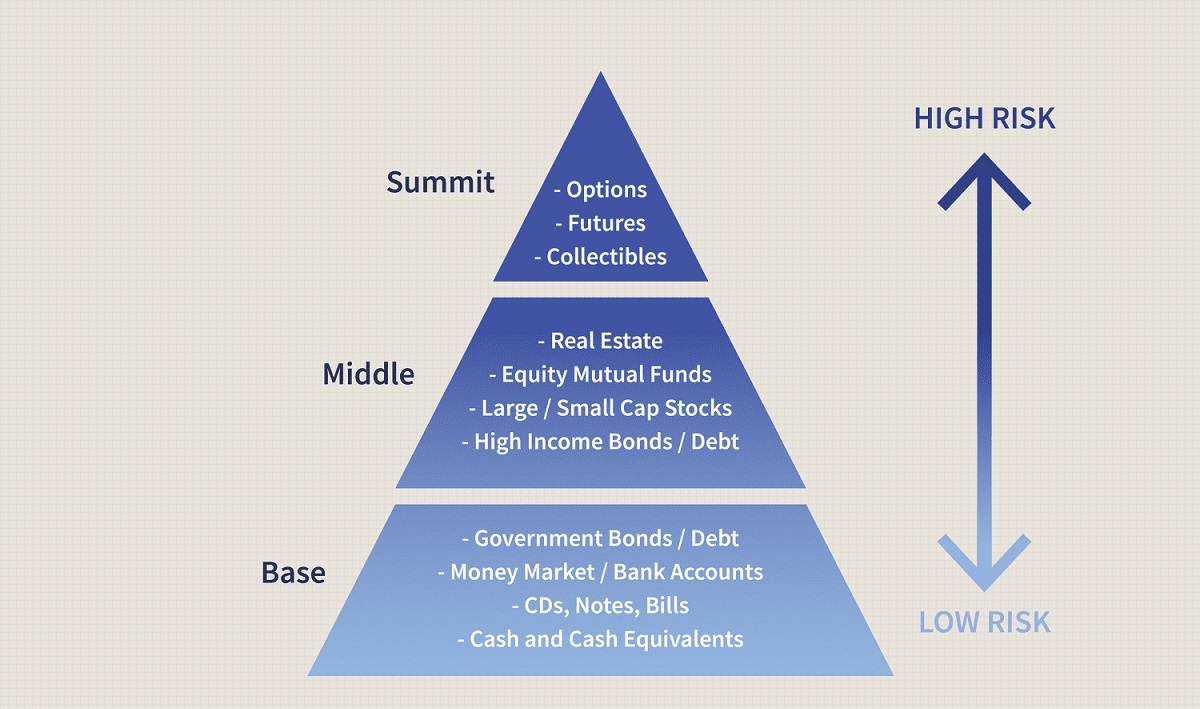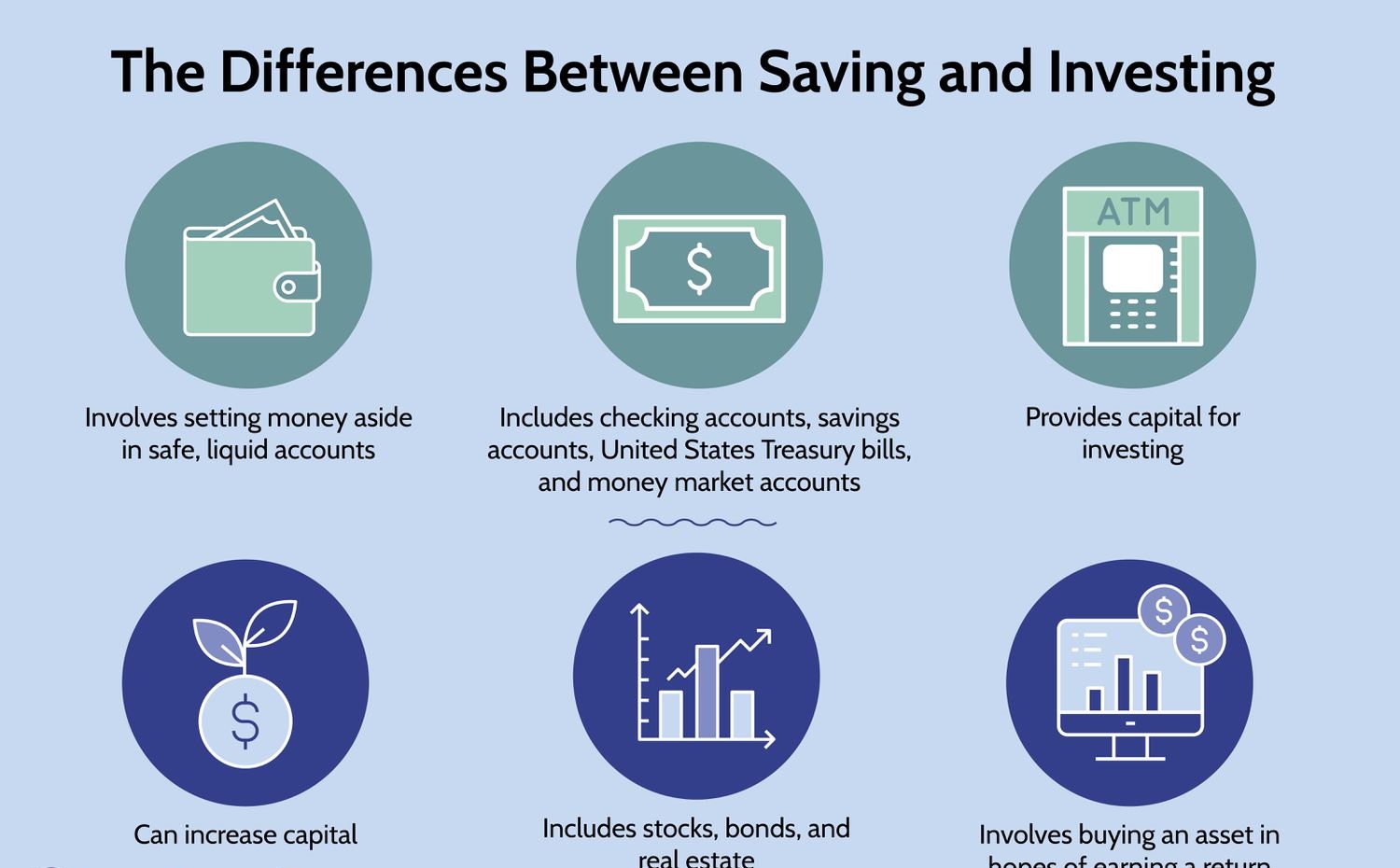Introduction
When it comes to investing, risk is a factor that cannot be ignored. However, not everyone is comfortable with high-risk investments that can result in substantial losses. For those seeking a more conservative approach, low-risk investments can offer a sense of security and stability.
Low-risk investments typically prioritize preserving capital over maximizing returns, making them an attractive option for cautious investors. While low-risk investments may not offer significant growth potential, they aim to protect your principal investment from loss.
In this article, we will explore some low-risk investment options available to individuals looking for a balance between stability and modest returns. From traditional avenues like certificates of deposit and treasury securities to alternative options like peer-to-peer lending and real estate investment trusts, we will discuss various investment vehicles that can help diversify your portfolio while minimizing risk.
It’s important to note that while these investments are generally considered low risk, they still carry some degree of inherent risk. It’s always recommended to carefully assess your risk tolerance and consult with a financial advisor before making any investment decisions.
Now, let’s delve into the world of low-risk investments and explore the options available to you.
Certificates of Deposit (CDs)
Certificates of Deposit (CDs) are a popular choice for low-risk investors looking to earn a fixed rate of return over a specified period. With a CD, you deposit a certain amount of money with a bank or financial institution for a predetermined length of time, ranging from a few months to several years.
CDs offer a higher yield compared to traditional savings accounts and are insured by the Federal Deposit Insurance Corporation (FDIC) up to $250,000, making them a safe investment option. The interest rate offered on a CD is typically higher than that of a regular savings account, and the longer the term, the higher the interest rate tends to be.
One of the key features of CDs is their fixed maturity date, which means you cannot withdraw your funds before the term expires without incurring a penalty. This guarantees that you will receive the full principal amount back at the end of the term, plus the accumulated interest.
CDs are suitable for individuals who have a specific time frame in mind for their investment and do not require immediate access to the funds. They are particularly attractive for short-term financial goals or as a part of a diversified investment portfolio.
It’s important to shop around to ensure you are getting the best CD rates. Different banks and credit unions may offer different interest rates and terms. Be sure to carefully review the terms and conditions of the CD, including any early withdrawal penalties.
In summary, certificates of deposit provide a low-risk investment option with a guaranteed return of principal and a fixed interest rate. They are ideal for individuals who have a specific time horizon and are looking to grow their savings without taking on significant risk.
Treasury Securities
Treasury securities, also known as T-bills, T-notes, and T-bonds, are debt instruments issued by the U.S. Department of the Treasury to finance the government’s spending needs. These securities are considered one of the safest investments available, as they are backed by the full faith and credit of the U.S. government.
There are three types of treasury securities:
- Treasury Bills (T-bills): These have a maturity period of less than a year, typically ranging from a few days to 52 weeks. T-bills are sold at a discount to their face value and do not pay regular interest. Instead, investors earn the difference between the discounted purchase price and the face value upon maturity.
- Treasury Notes (T-notes): These have a maturity period of 1 to 10 years and pay interest every six months. T-notes are issued with fixed interest rates determined at the time of purchase.
- Treasury Bonds (T-bonds): These have a maturity period of 10 to 30 years and pay interest every six months. Like T-notes, T-bonds are also issued with fixed interest rates.
Treasury securities are considered risk-free, as there is virtually no chance of default by the U.S. government. They provide a steady stream of income through interest payments and return the principal amount upon maturity.
One of the advantages of treasury securities is their liquidity. They can be easily bought and sold in the secondary market before their maturity date. This flexibility allows investors to cash in their investments earlier if needed, although the market price may fluctuate.
Investing in treasury securities is a viable option for risk-averse individuals seeking a stable source of income. They are often used as a hedge against inflation and as a way to diversify investment portfolios.
Keep in mind that treasury securities may not offer high returns compared to other investment options. However, they are an excellent choice for preserving capital and mitigating risk in uncertain economic climates.
In summary, treasury securities provide a low-risk investment opportunity backed by the U.S. government. They offer fixed interest payments and return the principal at maturity, making them an attractive option for risk-averse investors.
Money Market Funds
Money market funds are investment vehicles that pool together funds from multiple investors and invest in short-term, low-risk securities such as Treasury bills, certificates of deposit, and high-quality commercial paper. These funds aim to maintain a stable net asset value (NAV) of $1 per share, making them a low-risk investment option.
Money market funds provide investors with a way to earn a modest return on their cash while maintaining liquidity. They are typically managed by professional money managers who carefully select the investments based on their credit quality and liquidity.
One of the key advantages of money market funds is their accessibility. Investors can easily buy or sell shares of a money market fund at any time, allowing for quick access to their funds when needed. However, it’s important to note that while money market funds strive to maintain a stable NAV, there is still a slight possibility of a small fluctuation in the share price.
Money market funds are often used as an alternative to traditional savings accounts because they generally offer higher yields. While they may not provide significant growth potential, they provide a safe place for investors to park their cash and earn a reasonable return.
It’s important to understand that money market funds are not guaranteed by the government, unlike certificates of deposit or treasury securities. However, many money market funds have implemented credit quality standards and conservative investment strategies to minimize the risk of loss.
Investors interested in money market funds should carefully review the fund’s prospectus, which provides detailed information about the fund’s objectives, risks, and expenses. Additionally, it’s important to consider factors such as fees and expenses associated with the fund, as these can eat into the overall return.
Overall, money market funds offer a low-risk investment option for individuals looking to earn a competitive return on their cash while maintaining liquidity. They provide a convenient and accessible means of investing in short-term, low-risk securities.
Municipal Bonds
Municipal bonds, or “munis,” are debt securities issued by state and local governments to fund various public projects, such as infrastructure development, schools, and hospitals. These bonds offer low-risk investment opportunities and are particularly attractive to investors seeking tax advantages.
One of the key advantages of municipal bonds is that the interest income earned is generally exempt from federal income taxes. In some cases, the interest may also be exempt from state and local taxes, depending on the issuer and the investor’s residence.
Municipal bonds come in various types, including general obligation bonds and revenue bonds. General obligation bonds are backed by the issuer’s full taxing authority, while revenue bonds are supported by the revenue generated from a specific project, such as a toll road or a water treatment facility.
Investing in municipal bonds can offer a steady and predictable income stream, as the interest payments are typically made semi-annually. Additionally, municipal bonds are known for their relatively low default rates, making them a relatively safe investment option.
However, it’s important to note that not all municipal bonds have the same level of risk. It’s crucial for investors to evaluate the creditworthiness of the issuing entity and assess the potential risks associated with the investment.
Before investing in municipal bonds, it’s advisable to carefully review the bond’s prospectus, which provides detailed information about the bond’s terms, maturity, and potential risks. Additionally, consider seeking advice from a financial advisor who can help you navigate the complexities of the municipal bond market.
In summary, municipal bonds offer a low-risk investment option with potential tax advantages. They provide investors with a way to support local infrastructure projects while earning a predictable income stream.
Corporate Bonds
Corporate bonds are debt securities issued by corporations to raise capital for various purposes, such as expanding their operations, funding acquisitions, or refinancing existing debt. Investing in corporate bonds can provide investors with a relatively low-risk opportunity to earn regular interest payments.
One of the key advantages of corporate bonds is their potential for higher yields compared to other low-risk investments, such as treasury securities or certificates of deposit. The yield on a corporate bond is influenced by various factors, including the creditworthiness of the issuing corporation and prevailing interest rates.
Corporate bonds have different credit ratings assigned by credit rating agencies, indicating the likelihood of timely interest payments and the repayment of principal. Bonds with higher credit ratings are considered less risky and often offer lower yields, while lower-rated bonds may offer higher yields but come with increased credit risk.
Investors interested in corporate bonds should carefully consider the creditworthiness of the issuing corporation and their risk tolerance. Credit rating agencies provide valuable insights into the financial health of corporations and their ability to meet their debt obligations.
In addition to credit risk, it’s essential to consider interest rate risk. Corporate bond prices are inversely related to changes in interest rates. When interest rates rise, the prices of existing bonds tend to fall, and vice versa. This means that if you need to sell your bonds before maturity, you may receive less than your initial investment.
Before investing in corporate bonds, it’s advisable to diversify your portfolio by investing in bonds of different issuers and industries. This helps mitigate the risk of a single default negatively impacting your investment.
Lastly, it’s important to note that corporate bonds are subject to market volatility and economic conditions. It’s advisable to carefully monitor the performance and financial health of the issuing corporations, as any adverse events or changes in market conditions can impact bond prices.
In summary, corporate bonds offer a low-risk investment opportunity for investors looking to earn regular interest payments. By assessing creditworthiness, diversifying investments, and monitoring market conditions, investors can harness the potential of corporate bonds while managing risk.
High-Yield Savings Accounts
High-yield savings accounts are a low-risk option for individuals looking to earn a competitive interest rate on their savings while keeping their funds easily accessible. These accounts, typically offered by online banks and some traditional banks, provide a higher interest rate compared to standard savings accounts.
One of the key advantages of high-yield savings accounts is the ability to earn interest on your savings without exposing your funds to significant risk. These accounts are typically insured by the Federal Deposit Insurance Corporation (FDIC) up to $250,000 per depositor, providing an added layer of protection.
The interest rates offered on high-yield savings accounts are generally variable and may change over time in response to market conditions. However, they often outperform the interest rates provided by traditional savings accounts, allowing your savings to grow at a faster pace.
While high-yield savings accounts offer attractive interest rates, it’s important to carefully review the terms and conditions associated with these accounts. Some banks may have minimum balance requirements, fees, or other restrictions that could impact your overall return.
Another consideration is the ease of access to your funds. High-yield savings accounts typically offer convenient online banking services, making it easy to manage your account and make withdrawals when needed. However, some accounts may have limitations on the number of transactions or transfers allowed each month.
High-yield savings accounts are suitable for individuals who prioritize the safety of their funds while still earning a competitive interest rate. They can be useful for short-term savings goals, emergency funds, or as a place to park excess cash temporarily.
When choosing a high-yield savings account, compare the interest rates and terms offered by different banks to ensure you are getting the best possible return on your savings. Additionally, consider factors such as customer service, online banking features, and any additional perks offered by the bank.
In summary, high-yield savings accounts provide a low-risk investment option with the potential for higher interest rates compared to traditional savings accounts. They offer a balance between accessibility, security, and the opportunity for your savings to grow over time.
Dividend-Paying Stocks
Dividend-paying stocks are a popular choice for investors seeking a combination of potential capital appreciation and recurring income. These stocks belong to companies that distribute a portion of their profits to shareholders in the form of dividends.
Dividends are typically paid on a regular basis, such as quarterly, semi-annually, or annually. They are typically in the form of cash, although some companies may also offer dividends in the form of additional shares of stock.
Investing in dividend-paying stocks offers several benefits. Firstly, dividends provide a steady stream of income for investors, allowing them to generate a passive cash flow. This can be particularly attractive for individuals seeking regular income, such as retirees.
Secondly, dividend-paying stocks can provide a buffer against market volatility. The presence of dividends can potentially offset any short-term capital losses and provide a level of stability to the overall return of the investment.
However, it’s important to note that not all dividend-paying stocks are created equal. Different companies have varying dividend policies, and their ability to sustain and grow dividends may depend on several factors, including their financial performance, industry dynamics, and economic conditions.
Investors interested in dividend-paying stocks should conduct thorough research to identify companies with a history of consistent dividend payments and the potential for future dividend growth. Financial metrics such as dividend yield, payout ratio, and dividend growth rate can provide valuable insights into the company’s dividend stability and potential.
Additionally, diversification is key when investing in dividend-paying stocks. Spreading your investments across different sectors and companies can help mitigate the risk associated with a single stock or industry.
Lastly, it’s important to remember that investing in dividend-paying stocks still carries some degree of risk. Stock prices can fluctuate, and dividends can be reduced or eliminated in times of financial distress. Therefore, it’s crucial to assess your risk tolerance and consider your overall investment strategy when including dividend-paying stocks in your portfolio.
In summary, dividend-paying stocks offer the potential for both capital appreciation and recurring income. They can be an attractive option for investors seeking a combination of growth and stability, but it’s essential to carefully research and diversify investments to manage risk effectively.
Blue-Chip Stocks
Blue-chip stocks are shares of large, well-established companies with a history of stable earnings, strong financials, and a solid reputation in their respective industries. Investing in blue-chip stocks can be an appealing low-risk option for investors seeking stability, consistent dividends, and potential long-term growth.
One of the primary advantages of blue-chip stocks is their track record of resilience during market downturns. These companies tend to have a diversified business portfolio, strong market positions, and the ability to weather economic uncertainties better than smaller, riskier companies.
Blue-chip stocks are known for their transferable qualities across generations. Many of these companies have proven their ability to adapt and thrive over decades, making them reliable long-term investments. They often have established brand recognition, loyal customer bases, and a proven ability to generate consistent revenue.
Moreover, blue-chip stocks have a history of providing regular dividends to their shareholders. These companies often have an established track record of consistent dividend payments and are known for increasing dividends over time. This makes blue-chip stocks attractive to income-focused investors seeking a reliable income stream.
While blue-chip stocks are generally considered low-risk investments, it’s important to note that no investment is entirely risk-free. Factors such as economic downturns, industry disruptions, or mismanagement can still impact the performance of blue-chip stocks.
Investing in blue-chip stocks requires diligence and research. Investors should examine key financial metrics, such as earnings growth, profit margins, and debt levels, to assess the financial health and stability of the company. It’s also important to consider the company’s competitive advantages, market trends, and industry outlook to make informed investment decisions.
Diversification is crucial when investing in blue-chip stocks. By spreading investments across different blue-chip stocks from various industries, investors can mitigate risk and capture the potential benefits offered by different sectors.
Overall, blue-chip stocks offer a combination of stability, dividends, and the potential for long-term growth. They are particularly appealing to risk-averse investors seeking reliable investments with the potential for consistent returns over time.
Index Funds
Index funds are a type of mutual fund or exchange-traded fund (ETF) that aims to replicate the performance of a specific stock market index, such as the S&P 500 or the Dow Jones Industrial Average. Investing in index funds can be an effective low-risk strategy for investors seeking broad market exposure and long-term growth.
One of the key advantages of index funds is their inherent diversification. By tracking a specific index, these funds provide investors with exposure to a wide range of stocks across different sectors and industries. This diversification helps mitigate the risk associated with investing in individual stocks, as the performance of the overall index tends to be less volatile.
Furthermore, index funds often have lower expense ratios compared to actively managed funds. This is because index funds aim to replicate the performance of the underlying index rather than relying on a team of portfolio managers to actively select and trade stocks. Lower expense ratios can contribute to higher overall returns for investors over the long term.
Investing in index funds is relatively straightforward and accessible to both new and experienced investors. These funds can be purchased through brokerage accounts, retirement accounts, or directly from fund providers. Additionally, index funds offer flexibility, as they can be bought or sold on any trading day at the prevailing market price.
It’s important to note that while index funds generally aim to replicate the performance of a specific index, they may not perfectly match the index’s returns due to factors such as tracking error and fund expenses. However, the goal of index funds is to closely track the performance of the index, providing investors with a simple and efficient way to participate in market growth.
Investors interested in index funds should consider factors such as the fund’s expense ratio, tracking error, and the breadth of the index it aims to replicate. Additionally, it’s essential to align the chosen index fund with your investment goals and risk tolerance.
In summary, index funds offer a low-risk investment option for individuals seeking broad market exposure and long-term growth. By providing diversification, lower expenses, and ease of access, index funds have become a popular choice for investors looking for a passive investment strategy.
Real Estate Investment Trusts (REITs)
Real Estate Investment Trusts (REITs) are investment vehicles that allow individuals to invest in a diversified portfolio of income-generating real estate properties. REITs offer a low-risk option for investors seeking exposure to the real estate market without the need for direct property ownership.
One of the main advantages of investing in REITs is their potential for steady income. REITs are required by law to distribute a significant portion of their taxable income to shareholders in the form of dividends. This can provide investors with a consistent cash flow, making REITs appealing to income-focused investors.
Another benefit of investing in REITs is the ability to access a diverse range of real estate assets. REITs typically invest in various property types, such as residential properties, office buildings, retail spaces, and healthcare facilities. This diversification helps mitigate risk, as any potential underperformance in one sector may be offset by the performance of others.
REITs offer the advantage of professional management. These investment vehicles are typically managed by experienced real estate professionals who handle property acquisition, leasing, and maintenance on behalf of investors. This allows individuals to benefit from the expertise of professional managers without the need for active involvement in property management.
Moreover, REITs are publicly traded on major stock exchanges, providing liquidity and ease of buying and selling. Unlike direct real estate investments, which can be illiquid and require substantial capital, investing in REITs allows individuals to access the real estate market with smaller investment amounts.
It’s important to note that while REITs can provide a low-risk investment opportunity, they are still exposed to some level of risk. Factors such as economic downturns, fluctuations in property values, and changes in interest rates can impact the performance of REITs. As with any investment, thorough research and due diligence are essential.
Investors interested in REITs should carefully evaluate the specific REIT’s financial health, the quality of its properties, and its historical dividend performance. Additionally, it’s important to consider the fees associated with investing in REITs, including management fees and brokerage commissions.
In summary, Real Estate Investment Trusts (REITs) offer a low-risk avenue for individuals to invest in income-generating real estate properties. With their potential for steady income, diversification, professional management, and liquidity, REITs can be an attractive option for investors looking to access the real estate market.
Peer-to-Peer Lending
Peer-to-peer lending, also known as P2P lending or marketplace lending, is a form of investment where individuals lend money directly to borrowers through online platforms. This alternative investment option offers the potential for attractive returns while diversifying one’s investment portfolio.
One of the key advantages of peer-to-peer lending is the ability to earn higher interest rates compared to traditional fixed-income investments. By cutting out traditional financial intermediaries such as banks, P2P lending platforms can connect borrowers with lenders more efficiently, resulting in potentially higher returns for lenders.
Investing in peer-to-peer lending allows individuals to contribute directly to the success of small businesses or individuals seeking personal loans. This socially impactful aspect of P2P lending can be appealing to investors who want their money to support borrowers who may have had difficulty accessing loans through traditional channels.
Additionally, P2P lending platforms often use rigorous credit evaluation processes to assess borrower creditworthiness and determine the risk level associated with each loan. This helps lenders make informed investment decisions and manage risk effectively.
However, it’s important to note that investing in peer-to-peer lending carries some level of risk. There is a possibility of borrowers defaulting on their loans, resulting in a potential loss of principal. Therefore, it’s crucial for investors to diversify their investments across multiple loans and assess the risk associated with each borrower carefully.
Investors interested in peer-to-peer lending should research and choose reputable P2P lending platforms that have a track record of rigorous loan underwriting and borrower screening processes. It’s important to thoroughly review the platform’s terms and conditions, fees, and investor protections before committing funds.
Moreover, investing in P2P loans requires ongoing monitoring of the investment portfolio. Regular evaluation of loan performance, borrower repayment history, and platform updates will help investors make informed decisions about reinvesting or withdrawing funds.
In summary, peer-to-peer lending offers investors an alternative investment avenue with the potential for attractive returns. By directly lending to borrowers, individuals can diversify their investment portfolios and contribute to the success of small businesses or individuals in need of loans. As with any investment, careful research, diversification, and ongoing monitoring are essential when participating in peer-to-peer lending.
Annuities
Annuities are financial products that provide a guaranteed stream of income over a specified period or for the rest of an individual’s life. They are often offered by insurance companies and can be an attractive low-risk option for investors looking for a predictable income source during retirement.
One key advantage of annuities is their ability to provide a steady stream of income that can supplement other sources of retirement income, such as pensions and Social Security. Annuities can be structured to provide regular payments for a fixed period (period certain annuity) or for the lifetime of the annuity holder (lifetime annuity).
Another advantage of annuities is their tax-deferred growth potential. This means that any earnings within the annuity are not subject to income tax until they are withdrawn. This can be beneficial for individuals looking to accumulate wealth and defer tax payments until they are in a lower tax bracket during retirement.
Guaranteed lifetime income options, such as a lifetime annuity, can provide peace of mind for individuals worried about outliving their retirement savings. These annuities offer a predictable stream of income, regardless of market conditions or fluctuations in interest rates.
However, it’s important to note that annuities can have associated fees and expenses, including sales charges, administrative costs, and surrender charges for early withdrawal. It’s crucial for individuals considering annuities to carefully review the terms and conditions, including any potential fees and charges, before making a commitment.
Moreover, annuities may not provide the same growth potential as other investment options, such as stocks or real estate. The focus of annuities is providing a guaranteed income, rather than maximizing capital appreciation.
When considering annuities, it’s essential to assess your individual financial situation, risk tolerance, and retirement goals. Consulting with a financial advisor can help you determine if an annuity aligns with your overall financial plan and retirement needs.
In summary, annuities offer a low-risk investment option for individuals seeking a guaranteed stream of income during retirement. With their tax-deferred growth potential and the ability to provide lifetime income, annuities can be a valuable component of a diversified retirement income plan. However, it’s important to carefully review the terms and associated fees before committing to an annuity.
Conclusion
When it comes to investing, low-risk options can provide stability and peace of mind for individuals seeking to protect their capital while still earning a reasonable return. In this article, we explored several low-risk investment options, each with its own advantages and considerations.
Certificates of Deposit (CDs) offer the guarantee of the principal amount and a fixed interest rate over a specific term. Treasury securities provide a safe haven backed by the U.S. government and are ideal for risk-averse investors. Money market funds offer liquidity, convenience, and competitive yields for individuals looking to grow their savings while maintaining accessibility.
Municipal bonds provide a low-risk opportunity to invest in public projects while benefiting from potential tax advantages. Corporate bonds offer stability and the potential for higher yields compared to other low-risk investments. High-yield savings accounts provide attractive interest rates while keeping funds easily accessible.
Dividend-paying stocks offer both potential capital appreciation and recurring income, especially from blue-chip companies known for their stability. Index funds provide diversification and the opportunity to match the performance of a specific stock market index. Real Estate Investment Trusts (REITs) allow investors to benefit from income-generating real estate properties without direct ownership.
Peer-to-peer lending allows investors to earn attractive returns by directly lending to borrowers, while annuities provide a guaranteed income stream for retirees.
When choosing low-risk investments, it’s essential to consider personal financial goals, risk tolerance, and the specific features of each investment option. Diversification, thorough research, and consultation with a financial advisor can help individuals make informed decisions that align with their unique financial circumstances.
In the end, striking the right balance between low risk and potential returns is a personal decision. It’s crucial to find investments that align with your financial goals, time horizon, and risk appetite. By carefully selecting and monitoring low-risk investments, individuals can establish a solid foundation for their financial future.

























